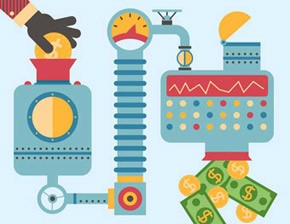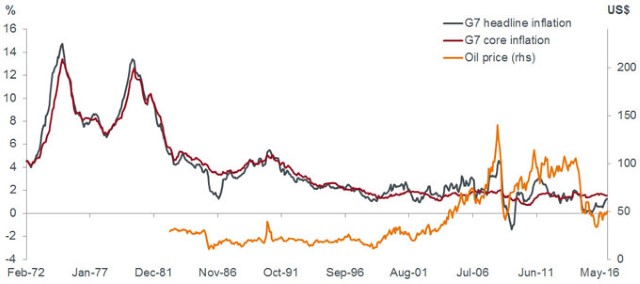Inflation — the dog that never barks

The biggest surprise last year was not only the persistent mis-forecasting of bond yields but also the persistent mis-forecasting of inflation1. Jenna and I have written extensively about how a traditional economics training can be detrimental to a career in the bond markets!
Why? Because a lot of those traditional models, assumptions and relationships do not seem to hold in this rather dystopian world in which we live. The world’s major central banks seem to be having a crisis of confidence themselves as their models no longer seem to work. Janet Yellen, Chair of the US Federal Reserve (Fed), has acknowledged the puzzle of why inflation is not stronger. She has been dismissing the weakness of inflation as being transitory for many years now! Given that we have printed over $12 trillion through quantitative easing (QE – asset purchase programmes) you would expect inflation to have reared its head by now. Having said that, in a normal economic cycle2 inflation does rise late in the cycle and is generally met by rising interest rates, tight labour markets, high oil prices and flattening yield curves3.
As former Fed Governor Daniel Tarullo said in October of last year “…we do not, at present, have a theory of inflation dynamics that works sufficiently well to be of use for the business of real time monetary policymaking.”
The three ‘D’s and the macro outlook
[caption id=”attachment_249059″ align=”alignnone” width=”340″] Source: Getty Images[/caption]
Source: Getty Images[/caption]
We have been at pains to explain that this cycle is very different. We have written extensively about the three ‘D’s of: tech disruption (Amazonisation), ageing demographics4 (Harry Dent), and the debt trap5 (Richard Koo). These all chime with the now consensual view expressed by Larry Summer’s secular stagnation thesis6. We really struggle to see how economies can reach ‘escape velocity’. The US has basically plodded along at 2% economic growth for the last six years. We accept it may be nearer to 3% this year but that may be the exception, not the rule.
The good news is that we are experiencing a cyclical upturn in the world economy, driven by the Chinese credit impulse7, weaker dollar/cheap emerging market (EM) funding, a bounce in energy capital expenditure (capex)8 and loose global financial conditions. We would suggest this cyclical uptick should not be confused with the long-term structural reasons impeding growth and inflation. However, if one was to make the case for a structural breakout in inflation (and inflation expectations) now is not a bad starting point: decent growth; tight labour markets; a high oil price; strong equity markets, and confident businesses and consumers!
Throw out the old economics books
We have had considerable success in dismissing conventional economics and instead focusing our thinking on the Japanese experience to determine the macroeconomic outlook. Hence we have been long duration (interest rate sensitivity) for much of the last five years — completely against consensual thinking. Much of our client base remain very short of duration and of bonds in general, and instead sit content and overweight in illiquid alternative assets9.
Unfortunately, they are probably working from the same economics books that we once used! We have already written about the broken Phillips curve10. The lack of wage growth seems to be a global phenomenon. But let us first explain the conventional but potentially flawed model and then give you our take on the modern gig economy.
[caption id=”attachment_249044″ align=”alignnone” width=”290″] Source: Getty Images[/caption]
Source: Getty Images[/caption]
The stylised model is of an economy making one product, in one factory, with one homogenous workforce (realistic I hear you say). Anyway, assuming the economy is running too hot, the factory owner needs to pay the workers more to expand output (for example, run an extra shift or work overtime). Since labour costs have gone up (ie, input costs) he then passes this cost onto the customers by raising his selling price — thus goods price inflation increases. The workers see this and demand a wage rise and you get a goods/wages price spiral. 1970s here we come?
A little confusion in the markets
Now, do we live in this world? No! However, we do accept there is some evidence of rising wages at the lower end in the US and the UK, primarily due to minimum wage inflation, and at the top end, such as google programmers. Further, a number of states and indeed industries are reporting some wage pressure. But the key point is that we see virtually no evidence that rising input prices are being pushed through to top lines (the selling prices that contribute to a company’s sales revenue, the first line in an accounting income statement). Indeed, in this transparent world with plenty of capacity it is very hard to push up prices and get away with it! Sure there are a few isolated industries but nothing material in our opinion. Again, do not confuse a cyclical uptick (rise) with a structural breakout (a long-term trend) in inflation and growth. This cycle’s amplitude is much lower and longer than previous cycles as we have written about recently.
Time for an illustration …
A good example of this lack of pass through of increasing wage costs is Whitbread, the leisure group that owns Costa Coffee. Now the barista is getting a more reasonable wage due to minimum wage legislation but Whitbread’s response to this is a £150m cost saving programme to absorb this cost (and the extra cost of importing coffee due to the depreciation, or fall in the value, of sterling post the Brexit vote).
Again, some clients confuse imported inflation, which we see purely as a cost or a tax, with excess of demand inflation (demand pull). This is highly topical in the inflation debate as some of the inflation is in ‘non-discretionary’ costs, such as healthcare and housing. Walmart’s recent announcement that it is raising its starting wage to US$11 an hour is topical. Arguably, the US retail giant is sharing the windfall gain of the corporate tax reforms with its employees. Wage costs will rise, but will this cause Walmart to put up prices? I think not! The next day Walmart announced they were cutting thousands of store manager positions and adding new lower paid positions! In addition, they announced they were closing 63 (roughly 10%) of Sam’s club stores with 1000’s of redundancies. 12 of these clubs will be converted to e-commerce fulfilment centres — they are increasing their technology spend to compete with Amazon!
The nature of work is changing
Further, we read a lot about the hollowing out of middle and low incomes — real wage increases are hard to demand or find. Work is now more divisible, transparent and flexible. The Trump administration originally talked about a robot tax. Now they are discussing a capital allowance tax break to replace labour with capital. Robotics and artificial intelligence seem very deflationary11 to us. We also have part time labour, zero hour contracts and a lack of trade union power. Indeed, we arguably have an underclass of job takers who live a very ‘precariat’12 existence; example: the Uber driver, being an hourly price taker!
The deceptive headline inflation
As always, the Fed’s reaction function to all this is key. They have raised rates five times with inflation below target. So, you have to argue they are more concerned about loose financial conditions and potential wage inflation than targeted personal consumption expenditures (PCE) inflation. They also target other core types of inflation ie, consumer prices index (CPI) and producer prices index (PPI). Even here we need to be super careful — core or underlying inflation has done remarkably little for a very long time. This excludes volatile items such as food and energy.
Some equity managers get overexcited when a rising oil price causes headline inflation to rise, whereas some parts of the bond community get overexcited when falling oil prices cause headline inflation to sink dramatically. Even core CPI has a few oddities in it — a major part is an implied rent cost for housing — recently this has been high but it is expected to fall. Second hand car prices post the hurricane and aggressive mobile phone price deflation can cause these rates to oscillate around. Again, we do not expect a structural breakout in core underlying inflation! As the chart shows, core inflation in the G7 has been hovering closely around the 2% level for a number of years now.
G7 inflation and crude oil price history
[caption id=”attachment_249011″ align=”alignnone” width=”640″] Source: Bloomberg, Janus Henderson Investors, monthly data, 29 February 1972 to 31 December 2017.[/caption]
Source: Bloomberg, Janus Henderson Investors, monthly data, 29 February 1972 to 31 December 2017.[/caption]
A Trichet moment?
Some commentators argue the strength of the global economy has given other central banks room to raise rates. Certainly, after the meeting of central bank officials (hosted by the Bank for International settlements (BIS) in Sintra), central banks do seem to be targeting financial conditions and arguably rightly so. So, it is not so much that we worry about inflation rearing its head, rather, people and markets will (or may) worry about it. The Trump fiscal reforms and potential infrastructure spending seem ill timed given where we are in the cycle (surely keep your fire power for bad times?). This, combined with some evidence of rising wages (not necessary passed through to CPI) will give the Fed the opportunity and certainly justification to raise rates. Arguably, the problem is the narrow targeting of inflation rather than a much broader definition of financial conditions and asset price inflation. So, we could continue to see the Fed raise rates with conventional inflation below target — how extraordinary! We remember when Mr Trichet, President of the European Central Bank, rather famously and misguidedly raised rates twice in 2011 with the euro-dollar exchange rate at 1.4 and the oil price at US$110. Sure, the energy cycle dances to a different tune but hey, that was a legendary policy mistake.
Waiting for the dog to bark?
Rightly or wrongly, risk markets are experiencing a melt up. Financial conditions remain very loose, the oil price is high and now we have an ill timed fiscal expansion. We expect the market to discount higher rates and more growth than a few weeks ago. We also expect the market to focus on higher wage inflation and infer it gets passed to consumer inflation. So, we are not fighting this quite significant cyclical uptick. We expect it to fade in the second half but we need to get there first. We remain shorter duration than normal, expecting cyclical factors to outshine the long term structural factors for a short time. From an equity manager’s perspective: “live in growth, but holiday in value!” So, enjoy the holiday — but unfortunately, they never last that long! Or to put it another way, the dog may growl but we are not convinced that it will bark!
- Inflation: the rate at which the prices of goods and services are rising in an economy. CPI, PCE and PPI are a few common measures.
- Economic cycle: the fluctuation of the economy between expansion (growth) and contraction (recession). It is influenced by many factors including household, government and business spending, trade, technology and central bank policy.
- Yield curve: a graph that plots the yields of similar quality bonds against their maturities. In a normal/upward sloping yield curve, longer maturity bond yields are higher than short-term bond yields. A yield curve can signal market expectations about a country’s economic direction.
- Ageing demographics, reference paper: Demographics Cliff: How to Survive and Prosper During the Great Deflation of 2014 2019
- Debt trap, reference paper: The Escape from Balance Sheet Recession and the QE Trap: A Hazardous Road for the World Economy.
- Secular stagnation: a prolonged period of low or no economic growth within an economy. Reference paper: U.S. Economic Prospects: Secular Stagnation, Hysteresis, and the Zero Lower Bound; Lawrence H. Summers; Keynote Address at the NABW Policy Conference, 24 February 2014.
- Credit impulse: change in new credit issued as a percentage of gross domestic product (GDP). Loosely, a measure to compare spending to net new lending (rather than outstanding credit).
- Capital expenditure: spending on fixed assets such as buildings, machinery, equipment and vehicles in order to increase the capacity or efficiency of a company.
- Illiquid assets: securities that cannot be easily bought or sold in the market. For example, shares with a high market capitalisation are typically liquid as there are often a large number of willing buyers and sellers in the market.
- Phillips curve: the curve represents the long term relationship between unemployment and inflation in an economy. An inverse but stable relationship between wage inflation and unemployment, the curve implies that changes in the level of unemployment would have direct and predictable effects on wage inflation.
- Deflation: a decrease in the price of goods and services across the economy, usually indicating that the economy is weakening. The opposite of inflation.
- Precariat: a class of workers defined in many ways, such as by the instability and insecurity of their jobs, and the lack of benefits such as work pensions and paid holidays. Reference: Guy Standing’s book — The precariat: the new dangerous class
These are the views of the author at the time of publication and may differ from the views of other individuals/teams at Janus Henderson Investors. References made to individual securities do not constitute a recommendation to buy, sell or hold any security, investment strategy or market sector, and should not be assumed to be profitable. Janus Henderson Investors, its affiliated advisor, or its employees, may have a position in the securities mentioned.
Past performance does not predict future returns. The value of an investment and the income from it can fall as well as rise and you may not get back the amount originally invested.
The information in this article does not qualify as an investment recommendation.
Marketing Communication.
Important information
Please read the following important information regarding funds related to this article.
- An issuer of a bond (or money market instrument) may become unable or unwilling to pay interest or repay capital to the Fund. If this happens or the market perceives this may happen, the value of the bond will fall.
- When interest rates rise (or fall), the prices of different securities will be affected differently. In particular, bond values generally fall when interest rates rise (or are expected to rise). This risk is typically greater the longer the maturity of a bond investment.
- The Fund invests in high yield (non-investment grade) bonds and while these generally offer higher rates of interest than investment grade bonds, they are more speculative and more sensitive to adverse changes in market conditions.
- Some bonds (callable bonds) allow their issuers the right to repay capital early or to extend the maturity. Issuers may exercise these rights when favourable to them and as a result the value of the Fund may be impacted.
- If a Fund has a high exposure to a particular country or geographical region it carries a higher level of risk than a Fund which is more broadly diversified.
- The Fund may use derivatives to help achieve its investment objective. This can result in leverage (higher levels of debt), which can magnify an investment outcome. Gains or losses to the Fund may therefore be greater than the cost of the derivative. Derivatives also introduce other risks, in particular, that a derivative counterparty may not meet its contractual obligations.
- When the Fund, or a share/unit class, seeks to mitigate exchange rate movements of a currency relative to the base currency (hedge), the hedging strategy itself may positively or negatively impact the value of the Fund due to differences in short-term interest rates between the currencies.
- Securities within the Fund could become hard to value or to sell at a desired time and price, especially in extreme market conditions when asset prices may be falling, increasing the risk of investment losses.
- Some or all of the ongoing charges may be taken from capital, which may erode capital or reduce potential for capital growth.
- CoCos can fall sharply in value if the financial strength of an issuer weakens and a predetermined trigger event causes the bonds to be converted into shares/units of the issuer or to be partly or wholly written off.
- The Fund could lose money if a counterparty with which the Fund trades becomes unwilling or unable to meet its obligations, or as a result of failure or delay in operational processes or the failure of a third party provider.



